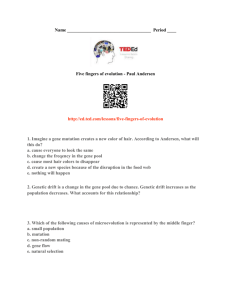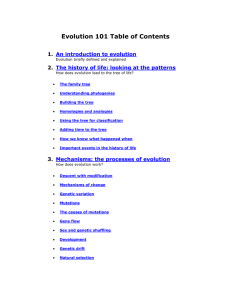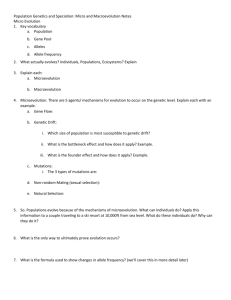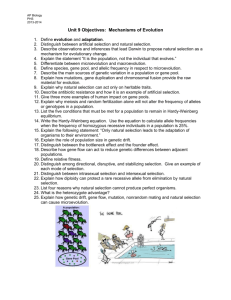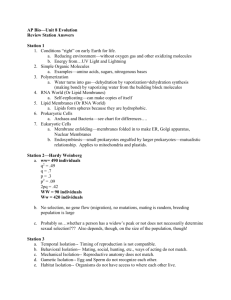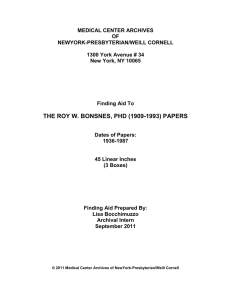Question 1 (Hint: Look in "Patterns- The family tree") What is the trait
advertisement
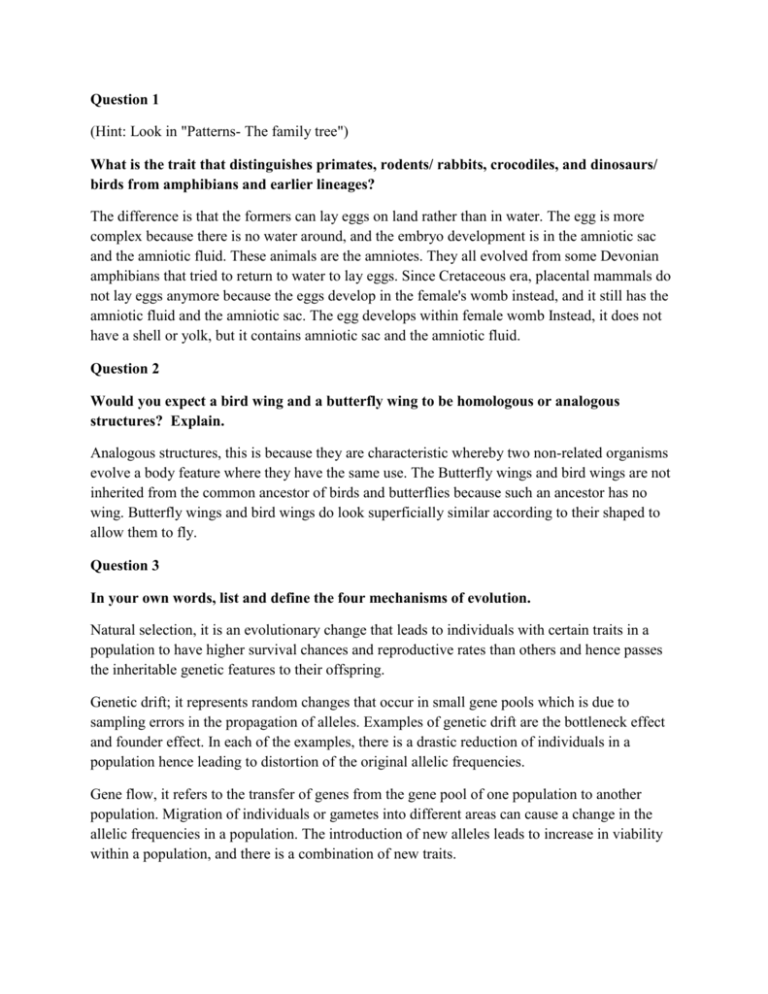
Question 1 (Hint: Look in "Patterns- The family tree") What is the trait that distinguishes primates, rodents/ rabbits, crocodiles, and dinosaurs/ birds from amphibians and earlier lineages? The difference is that the formers can lay eggs on land rather than in water. The egg is more complex because there is no water around, and the embryo development is in the amniotic sac and the amniotic fluid. These animals are the amniotes. They all evolved from some Devonian amphibians that tried to return to water to lay eggs. Since Cretaceous era, placental mammals do not lay eggs anymore because the eggs develop in the female's womb instead, and it still has the amniotic fluid and the amniotic sac. The egg develops within female womb Instead, it does not have a shell or yolk, but it contains amniotic sac and the amniotic fluid. Question 2 Would you expect a bird wing and a butterfly wing to be homologous or analogous structures? Explain. Analogous structures, this is because they are characteristic whereby two non-related organisms evolve a body feature where they have the same use. The Butterfly wings and bird wings are not inherited from the common ancestor of birds and butterflies because such an ancestor has no wing. Butterfly wings and bird wings do look superficially similar according to their shaped to allow them to fly. Question 3 In your own words, list and define the four mechanisms of evolution. Natural selection, it is an evolutionary change that leads to individuals with certain traits in a population to have higher survival chances and reproductive rates than others and hence passes the inheritable genetic features to their offspring. Genetic drift; it represents random changes that occur in small gene pools which is due to sampling errors in the propagation of alleles. Examples of genetic drift are the bottleneck effect and founder effect. In each of the examples, there is a drastic reduction of individuals in a population hence leading to distortion of the original allelic frequencies. Gene flow, it refers to the transfer of genes from the gene pool of one population to another population. Migration of individuals or gametes into different areas can cause a change in the allelic frequencies in a population. The introduction of new alleles leads to increase in viability within a population, and there is a combination of new traits. Mutations, this are the changes that occur in the DNA sequence that is usually within a gene or a chromosome of a living organism. Question 4 (Hint: Look in "Mechanisms- Natural selection") In your own words, give an example in nature of how natural selection works. An example of natural selection is where in an ecosystem there are giraffes with long necks and others short necks. If something occurred and low-lying shrubs decreased or died out the giraffes with short necks will not have enough food. After a few generations, all the giraffes will have long necks for their survival. Question 5 In your own words, describe the difference between microevolution and macroevolution. Microevolution is the process that involves the change in allele frequency that occurs within a single population while macroevolution is the change that occurs on a scale that transcends the boundaries of a single population. Part B: Multiple choice questions Question 1 In the following phylogenetic tree, which of the following are in the clade that has a therian mammal ancestor? monotremes and eutherians lepidosaurs and archosaurs monotremes and marsupials marsupials and eutherians Question 2 In the following phylogenetic tree, the unique lineage of archosaurs is represented by: a red line a green line a blue line a black line Question 3 In the following phylogenetic tree, which of the following is not a shared derived characteristic of therian mammals? pouch holoblastic cleavage placentation viviparity Question 4 (Hint: look in "Mechanisms- Descent with modification") In a population of beetles which can be either green or brown in color, the gene (allele) frequency of green beetles in 2009 was measured to be 36% and increased to 52% in 2010. The gene (allele) frequency of brown beetles in 2009 was measured to be 64% and decreased to 48% in 2010. True of False? This population of beetles is evolving. True False Question 5 Which of the following is the best example of the principle of "fitness"? a white rabbit living on a forested hill side compared to a brown rabbit living there. gorilla males with large testicles consistently producing more offspring than gorilla males with small testicles the most dominant chimpanzee male in the group eating more often than less dominant males a giraffe having thicker,spottier fur than another giraffe Question 6 Which of the following statements is TRUE? mutation are non-random only germline mutations can affect evolution natural selection is random mutation always affect the phenotype to the same extent Question 7 Hummingbirds feed on flower nectar and often have a beak whose shape is adapted specifically to only one flower shape, fitting in no other flower species. As a result, this hummingbird may only feed on that particular flower and is its only pollinator, creating a mutual dependency between the two species. This is an example of _facultative mutualism__________. (spelling counts; lower case letters only, please). Question 8 A field biologist discovers a population of pocket mice in Nebraska which has a very different phenotype of the other populations of pocket mice in the area. Which of the following is the best strategy the biologist should use in order to establish whether or not she has found a new species? compare the color, size, shape, and any other physical traits between the various populations to the newly discovered one and if they look at least 95% the same, consider them the same species. check to see what kind of habitat they live in, and if it is the same, consider them the same species check to see what they eat, at what time of the year they breed, how many offspring they generally produce, and what their social structure is, and if it is the same, consider them the same species Check to see if they would produce viable and fertile offspring when brought together to mate. If yes, then consider them the same species Question 9 The fact that a mule (hybrid offspring of a horse and a donkey) is sterile is an example of: reduction of gene flow genetic drift reproductive isolation geographic isolation Question 10 True or False. The mechanisms causing microevolution are different from those of macroevolution. true false Reference Mayr, E. (1982). The growth of biological thought: diversity, evolution, and inheritance. Harvard University Press. Avise, J. C. (1994). Molecular Markers, Natural History and Evolution: Natural History and Evolution. Springer Science Media. Nicoglou, A. (2015). Phenotypic Plasticity: From Microevolution to Macroevolution. In Handbook of Evolutionary Thinking in the Sciences (pp. 285318). Springer Netherlands. Rabosky, D. L. (2013). Diversity-dependence, ecological speciation, and the role of competition in macroevolution. Annual Review of Ecology, Evolution, and Systematics, 44, 481-502.
